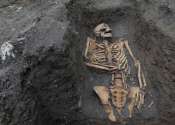Famed Egyptian archaeologist reveals details of ancient city
Egypt's best-known archaeologist on Saturday revealed further details on a Pharaonic city recently found in the southern province of Luxor.

Egypt's best-known archaeologist on Saturday revealed further details on a Pharaonic city recently found in the southern province of Luxor.
Archaeology
Apr 11, 2021
3
188

University of Otago research analyzing skeletal remains has found evidence of a range of ethnicities present on the Goldfields of Otago, proving some assumptions of the cultural make-up of early settler New Zealand to be ...
Archaeology
Apr 9, 2021
1
10

The largest flightless bird ever to live weighed in up to 600kg and had a whopping head about half a meter long—but its brain was squeezed for space.
Evolution
Mar 24, 2021
0
652

Newly excavated skeletal remains of an ankylosaurid—a large armored herbivore that lived during the Cretaceous Period—may indicate that members of this family of dinosaurs were able to dig, according to a study published ...
Paleontology & Fossils
Mar 18, 2021
1
1304

A lone cranium in an Italian cave wound up there after being washed away from its original burial site, according to a study published March 3, 2021 in the open-access journal PLOS ONE by Maria Giovanna Belcastro of the University ...
Archaeology
Mar 3, 2021
1
306

Social inequality was "recorded on the bones" of Cambridge's medieval residents, according to a new study of hundreds of human remains excavated from three very different burial sites within the historic city centre.
Archaeology
Jan 25, 2021
0
504

An international team of researchers has conducted a genomic study of 40 human remains recovered from parts of upper east Asia in what is now mostly Siberia. In their paper published in the journal Science Advances, the group ...

Skeletal remains of what are believed to have been a rich man and his male slave attempting to escape death from the eruption of Mount Vesuvius nearly 2,000 years ago have been discovered in Pompeii, officials at the archaeological ...
Archaeology
Nov 21, 2020
3
1040

The word "dinosaur" tends to evoke giant animals with massive bodies, long necks and tails, and tiny heads. These "quintessential dinosaurs" actually represent one prominent subgroup of the Dinosauria, the so called Sauropoda ...
Evolution
Nov 18, 2020
0
334

Bronze Age pastoralists in what is now southern Russia apparently covered shorter distances than previously thought. It is believed that the Indo-European languages may have originated from this region, and these findings ...
Archaeology
Oct 21, 2020
0
214